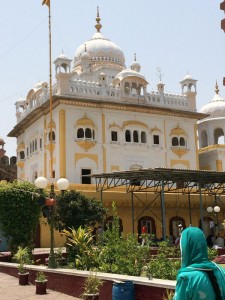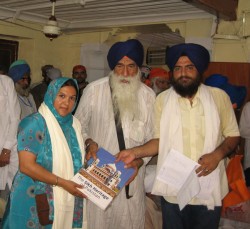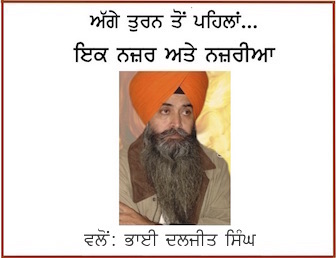Sikh News » Special News
Sikhs from Pakistan and India commemorate martyrdom anniversary of Guru Arjun Dev Ji at Lahore’s Gurdwara Dera Sahib which is to be “restored”
June 30, 2014 | By Indira Prahst
BY INDIRA PRAHST*
Last week hundreds of Sikhs in Pakistan united and together with over two hundred Sikh pilgrims from India to commemorate the martyrdom anniversary of Guru Arjun Dev Ji at Gurdwara Dera Sahib in Lahore.
Gurdwara Dera Sahib, situated opposite Lahore Fort near Badshahi Mosque, is the place where Guru Arjan Dev Ji was martyred in June 1606.

Gurdwara Dera Sahib in Lahore where the commemoration of the martyrdom anniversary of Guru Arjun Dev Ji was held.
According to one account, “He was made to sit on a burning hot sheet while boiling hot sand was poured over his body. After enduring five days of unrelenting torture Guru Arjan was taken for a bath in the river. As thousands watched he entered the river never to be seen again.”
Another account states, “The Gurdwara was built by Maharaja Ranjit Singh in the memory of Guru Arjan Dev, the fifth Sikh Guru who compiled the Adi Granth, the principal part of Sikh scriptures. … The followers of Guru Arjan Singh assert that it is the same spot where Guru Arjan Dev miraculously disappeared in 1606 A.D. in the waters of river Ravi. [At] the site where Guru Arjun Dev was martyred a Thara (platform) Sahib was built by Guru Hargobind Ji when he came to Lahore visiting Gur Asthans.”
The commemoration kicked off a day before hundreds of Sikhs arrived and paid their respects to Guru Arjun Dev Ji’s shrine while others enjoyed langar in forty plus temperatures. Gurdwara Dera Sahib has an immense history that is beyond the scope of this piece, but I wish to highlight that the exquisite interior design is often overlooked by its visitors. The resplendent tiled work and old frescos captivated me especially on this visit as they represented tangible markers of Sikhism.

Indira Prahst was presented with a saropa and a book on Sikh Heritage by Sham Singh, former president of PSGPC
One Sikh pointed out the frescos depicting Guru Nanak Dev Ji and how Sikh history was transmitted visually. A few years ago when I visited Gurdwara Dera Sahib, Bhai Sham Singh called me over to show me an old wooden door with carved images of Guru Nanak. “Beautiful and irreplaceable,” I remember telling him.
Much has been written about the powerful aura that is preserved in old shrines, derived from the old bricks, frescos, door frames, and delicate inlay work that has no match in today’s architectural realm.
To the pleasant surprise of many, on the following day at the commemorative ceremony an announcement was made about the “rebuilding” of the Dera Sahib which would be a joint effort by the former president of Delhi Sikh Gurdwara Management Committee (DSGMC), Paramjit Singh Sarna, and the Pakistan Sikh Gurdwara Parbandhak Committee.
While several Sikhs were delighted at this news, other Sikhs expressed their concern and wondered what was meant by “rebuilding” the Gurdwara Dera Sahib. Pakistan has for many years made great efforts not to harm the sentiments of Sikhs and to ensure their heritage is preserved, especially their Sikh Shrines. This has been reaffirmed to me by ministers that I have met there. So I have faith that this will not be tampered with as Pakistan has committed itself to the preservation of historical shrines which I have seen across Pakistan. The current understanding so far is that the Gurdwara Dera Sahib will be “restored.” Paramjit Singh Sarna has said to several media outlets that a part of the Gurdwara ‘Shaheedi Asthaan’ would not be changed at all during the restoration work and that the gurdwara would be built with the approval of the Waqf Board in Pakistan.
However, some Pakistani Sikhs I spoke to are firm about preserving the historical artwork, frescos, inlay work and the original architectural artefacts. “They cannot be destroyed and rebuilt,” some Sikhs from Nankana Sahib have told me. Ramesh Singh Arora, first Sikh Member of the Provincial Assembly (MPA) of Punjab, told me after the ceremony: “The Sikh shrines while being maintained must be preserved with their original art, frescos and architectural design. They are part of Sikh history and Sikh heritage.” He also added that he entered the political realm for the nation of Pakistan, but also as a Sikh to have greater representation and to continue to preserve their Sikh heritage and Sikh shrines which he was hopeful about.
The event started with a bhog ceremony of the Akhand Path, Shabad Kirten and speeches. Gopal Singh Chawla, Chairman of the Punjabi Sikh Sangat, who has spent hours volunteering his time for the Sikh Panth moderated the ceremony in the gurdwara, with many Sikh leaders from Pakistan giving or receiving saropas. These included Sardar Bhai Sham Singh, past president of the Pakistan Sikh Gurdwara Prabandhak Committee (PSGPC), Ramesh Singh Arora, Khalid Ali, Chairman, Evacuee Trust Property Board, Paramjit Singh Sarna, former chief of the Pakistan Sikh Gurdwara Parbandhak Committee, Bishen Singh, and Veer-G from Kartarpur Sahib, Narowal, who has spent many years overseeing Sikh Shrines and encouraging Sikh youth, to name a few.
I was surprised when I was also honoured with a saropa and was thanked for the academic work I do for the Sikh Panth and my positive news stories which have included Pakistani Sikh events and voices.
The sacrifices made by Guru Arjun Dev Ji were also highlighted in speeches. For some Sikhs, remembering Guru Arjun Dev Ji reminded Sikhs of the continuous struggle over a span of several hundred years to the present day to preserve their Sikh identity. Some Sikhs did not shy away from addressing the need for Khalistan in their speeches and saw this commemoration as inseparable from the Sikh struggle and sacrifices made to preserve the Panth.
In closing, with ebbs and flows of history and commemoration of Sikh struggles in their quest to preserve the Panth, Sikhs are fortunate they have been given a space to do that in Pakistan with support and many security measures taken to protect them. What I have noticed in particular here in Pakistan, is the respect given to them at commemorative events, as their Muslim brothers are able to empathize with their own past struggles.
In the words of Veer G: “Guru Arjun Dev Ji has given Sikhs light. He laid the foundation of Harminder Sahib, contributed the most Shabads (2218) and preserved the words of the Gurus through the Adi Granth. For Sikhs to move forward in these difficult times they must act according to Guru Granth Sahib. This is the moral compass that should dictate what Sikhs do in the present; then there will be more light.”
* Indira Prahst is Vancouver based sociologist & Race and Ethnic Relations Instructor, Langara College
To Get Sikh Siyasat News Alerts via WhatsApp:
(1) Save Our WhatsApp Number 0091-855-606-7689 to your phone contacts; and
(2) Send us Your Name via WhatsApp. Click Here to Send WhatsApp Message Now.
Sikh Siyasat is on Telegram Now. Subscribe to our Telegram Channel
Related Topics: Indira Prahst, Sikhs in Pakistan




